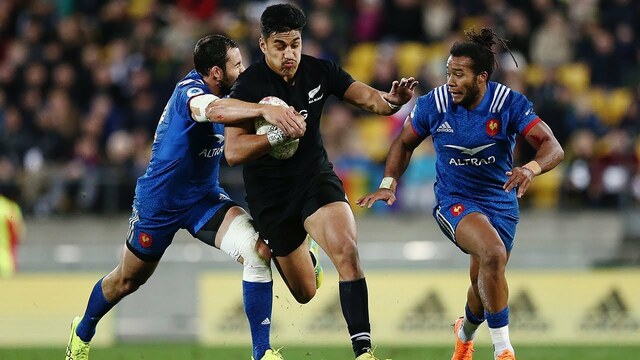Attacking the 13 channel – the All Black way!
Let’s get straight back to Eden Park and the first Test, and take stock of how the All Blacks were able to make the adjustments necessary to beat the France defence out wide.
France were more than capable of defending in the 13 channel when they were organized, with their number 12 Geoffrey Doumayrou doing the organizing, and scrum-half Morgan Parra supplying the support. As long as Doumayrou was in position, France looked well-ordered and their defence was hard to break down.
At half time, my best guess is that the New Zealand coaches and analysts spotted that French organization dropped off dramatically in that area when Doumayrou was not there to oversee it, and Parra was not able to pick up the slack.
The first hint of a problem had occurred midway through the first period:
This opportunity was created from the fourth phase of an All Black kick return. After three phases, New Zealand were able to establish a situation in centre-field, with both of the main French organizers stuck on the same side:

At the third ruck, the ball is in the middle of the field with both Doumayrou (circled) and Parra (out of shot) on the New Zealand right. The half-back Aaron Smith is passing out to the left, which means that a different defender will have to run the structure on that side.
As another two Barrett brothers connect (on this occasion, first five-eighth Beauden passing to second row Scott) and the shot widens out, the scenario does not look as familiar as the structure we observed in the first article:

The defender on the end of the line is France number 10 Antony Belleau, and as a result there are some small but significant differences in the French structure.
Teddy Thomas on the wing is twice as deep as normal (roughly ten metres off the line), and there is no pressure on Scott Barrett as he receives the ball from either Belleau or the defender inside him, number 8 Fabien Sanconnie. This allows Barrett to take the ball up to the line and deliver an offload in contact between Sanconnie and number 7 Kevin Gourdon to the third of the Barretts, Jordie – with Beauden finishing the move in the corner!
In the last half hour of the game, the floodgates finally opened as the All Blacks understood that they might be on to a good thing whenever they could move the ball away from Doumayrou and Parra target the ‘acting captain’ of the France wide D who replaced them:
Here France have kicked the ball into touch, and Geoffrey Doumayrou is the primary chaser following the ball – Parra is out of shot on the same side of the field as the centre:

The first issue is that the ball only clears the side-line by a couple of metres, enabling the All Blacks to field it and take the quick lineout throw immediately. Although Doumayrou is able to call up Thomas to protect the short-side, the open-side defensive chase is still a long way off, while New Zeland have four players outside the receiver (Jordie Barrett) working hard to get back in position to provide attacking width – right wing Ben Smith (4), hooker Cody Taylor (3) and the two centres, Anton Lienert-Brown (2) and Ryan Crotty (1) furthest out.
Again there is no pressure on the ball as it is passed across field, with France committed to a very passive drifting line:

The problem with a pure drift is not only that it concedes yardage on the wide outside of the field – it also concedes the support channels on the inside, with Smith and Taylor running straight past Bastareaud and Sanconnie to finish the try off in the right corner.
Perhaps the clearest example of New Zealand’s ability to score from situations when the wide French defence deteriorated came in the 64th minute:
The start-point is a ball-rip by number 8 Luke Whitelock which creates a turnover in midfield. When the ball is shifted out towards the right side-line, the France defence is again bereft of an organizer.
The result is a chaos of crossed purposes. As Cody Taylor receives the ball…

…Gourdon has turned his back on Taylor and is running towards his own goal-line, Sanconnie is flying forward having identified the wrong second receiver (Ngani Laumape), and the replacement wing Gael Fickou is stuck with his feet in concrete, looking in at the ball. It is a remarkable mess generated ultimately, by a complete failure of communication and connection – one which enables Damian McKenzie to race through unchallenged for the try.
Summary As in my previous article about attacking communication, defensive communication cannot be the responsibility of just one player in the modern game.
However good your defensive captain may be, he needs active support when he is ruled out of the play, or the attack goes to the side of the field away from him.
These are situations where the structure has to remain consistent, and defenders have to know they can predict, and therefore rely on the actions of the men inside and outside them.
The All Blacks demonstrated a high degree of game awareness (sparked by half-time analysis?) in the last half hour of the Test at Eden Park. They understood that France struggled to maintain their structures when Geoffrey Doumayrou was out of the defensive pattern – and after number 9 Morgan Parra went off in the 58th minute – and they exploited every opportunity when this occurred quite ruthlessly.












.jpg)

.jpg)







